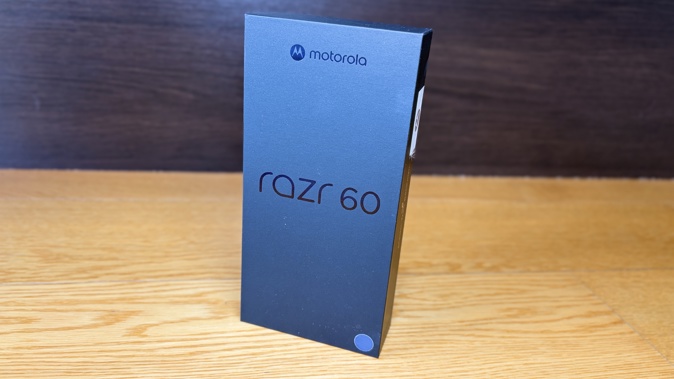
I know we should probably be taking them for granted by now, but I still find bendy phones a bit of a novelty. And that's coming from a guy who's reviewed a fair few of them.
In many ways, I feel like 2025 is the year they really started to come of age, moving from the category of pricey gimmick, with limited real-world specs, into a more mainstream, well set up, productive tool.
If you're considering a new phone, now's the time to consider a foldable - not just because it bends in the middle, but because it's just a good phone.
A fine example is the motorola razr 60 - a handset I was determined to judge objectively as a phone first, then a clamshell foldable second.
I need to start with the box.
Have you ever heard the expression, "There's nothing like the smell of a brand new phone?" No, of course you haven't. Why would anyone say that? Well, it turns out, Motorola literally adds a "Signature Packaging Fragrance" to enhance the unboxing experience, so the razr 60 definitely makes an impression before you even start flipping and calling.
It's available in Parfait Pink and Gibraltar Sea (dark blue) and you'll find a matching cover/bumper in the box. Initially I used this extra layer of protection but eventually I felt like it made the phone look and feel cheap and plasticky, so I took it off again. Although this means I run the risk of having to explain a damaged review unit when I send it back to Motorola, at least I feel cool when I slip it out my pocket to use it.
Besides, the razr 60 is more durably constructed than ever before; a stronger, titanium-based hinge plate, Corning Gorilla Glass Victus protecting the external display and an easy-grip, soft-touch faux-leather back panel, embossed with reflective Motorola and razr logos.
I'm a fan of the Motorola UI, because it's about as close to the stock Android 15 OS as you can get. Very little bloat and the settings are comprehensive without being overwhelming. However, unlike some other brands, I always find setting up a new Motorola is a bit more of a mission. You can transfer some settings, files and apps from your previous device but I was frustrated to discover not all my apps installed automatically and very few were pre-logged in for me when I opened them.
But if you're looking for AI options, you've definitely come to the right place. Motorola parks its own moto ai prompt on screen as a floating button (assuming you decide to use it). This means interactive AI is always just a tap away, no matter which app or browser window you have open.
As far as I'm concerned, right now there's two types of AI available to you on most premium smartphones; one is this kind - where you consciously have to summon it, like a genie from a bottle. On the razr 60, this option gets confusing quickly because depending on what's on your screen, you're met with several inquiry prompts including the option to use Co-pilot Vision or perhaps to "Ask Perplexity."
To muddy things even more, as an Android device, you also have the option to use Google's AI, Gemini, as your virtual assistant and general font of all knowledge.
So is moto ai it's own entity? Or just a portal to other AI services?
Maybe both. You see, the second type of AI is much less in-your-face. It's the AI that works away in the background, assisting you with your photos and videos without you even realising it. Taking note of your interactions and notifications so when you ask it to, "Catch Me Up" it knows what you mean and is able to sift through the spam, advertising and other fluff to provide you with information you actually need.
I'm sure, in time, I can keep fiddling with moto ai's settings to make it a little less intrusive and a lot more productive.
Let's just say I can assure you the razr 60 has all the AI options you could currently ask for - an then some.
None of that works without the right chip, of course. Although the MediaTek Dimensity 7400X chip is not the latest or greatest currently on the market, the "X" in its name means it's been specifically tweaked to run folding handsets like this one as efficiently and smoothly as possible - and that's certainly been my experience. Features like face unlock and the fingerprint reader work so fast, most times the phone has opened to the home screen before I've thought about unlocking it.
That applies to both displays by the way, and here, I will have to wax lyrical for a bit about my favourite feature on the razr 60; the external display.
While the pOLED outer screen is only 3.6-inches and some of it is obscured by the twin lenses of the primary camera array, you can still use it just like any other phone screen. For some reason, other clamshell folding phone producers insist on limiting the functionality of their external displays to showing the odd notification and giving you a limited choice of device-specific widgets to interact with.
I've never understood that. If I want to open my browser and scroll down a web page on my 3.6-inch screen, I should be allowed to. After all, it's my screen. If it's not a very satisfying experience, guess what? I probably won't do it again and I'll open the razr 60 up and use the 6.9-inch internal display instead. But I should at least have the choice.
That's exactly what the razr 60 offers; the choice to use the small, outer screen however you want. Rotate it. Put widgets on it. Reply to emails with it. Whatever.
Of course, the true advantage of this form factor is the ability to use that main camera to shoot selfie. The razr 60 has now added a fun "Photo Booth" option that fires off a series of four shots, one every three seconds, then compiles them in a snapshot-style collage. Motorola is also pretty proud of its gesture-based video controls; wave to start shooting, close your fist and hold to pause, or just show your fist to stop recording.
You see? This is that behind-the-scenes AI at work.
The razr 60 is a phone full of little tricks like that; give the phone a little double twist and the camera app opens. Double-tap the back of the phone to launch your choice of customisable shortcut.
But back to the cameras. Those two outside lenses are a 50MP main shooter and a 13MP Ultra-Wide, giving you a selection of 24mm, 35mm or 50mm options for portraits, sharp macro shooting and decent optical zoom. Here are a couple of shots using different zooms and lenses...
Interestingly, the razr 60 is very well equipped when it comes to the internal selfie-cam too. The 32MP sensor provides incredibly clear footage in all lighting conditions. Selfie videos can be taken at 30fps and 60fps in FHD, or 30fps in 4K.
There are also a few other interesting camera options like Dual Capture and Tilt Shift - the latter creating interesting effects with light and mixed focus. Or you can shoot video in handy-cam mode - with the phone open at right-angles. This is fun to do but despite the more robust redesign of the hinge, I would have preferred one that's a bit stiffer. I found it didn't really stay at the angle I wanted it to, especially if I was on the move.
Battery life from the 4,500mAh battery is terrific. I guess that might be because a lot of time you're using the device, you're doing it on the smaller, external display. I also love that you can charge wirelessly at 15W.
See? There's a lot more to this handset than just the fact it folds - although it does that very well too. If you thought foldables were just a fad, it's time to think again.
Take your Radio, Podcasts and Music with you



















